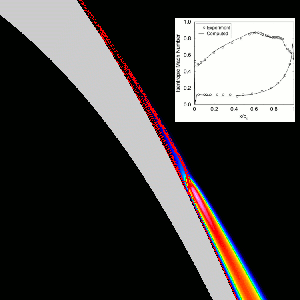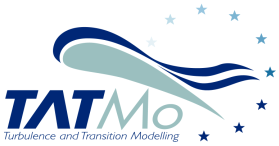TATMo

Turbulence and Transition Modeling for Special Turbomachinery Applications
Contract no. AST5-CT-2006-030939
Project no. FP6-2005-AERO-1-030939
Coordinator: MTU Aero Engines GmbH (D)
start: 1st October 2006
duration: 36 months
status: partner
Contractors:
MTU Aero Engines GmbH (D), Snecma (F), Avio S.p.A. (I), Industria de Turbopropulsores (E), Techspace Aero (B), Rolls-Royce Deutschland Ltd & Co (D), DLR (D), Office National d'Etudes et de Recherche Aeronautique (F), Universita' degli Studi di Firenze (I), Cenaero (B), Technical University of Berlin (D), University of Cambridge (UK) Von Karman Institute for Fluid Dynamics VKI (B), Universita' degli Studi di Genova (I), Universidad Politecnica de Madrid (E), Imperial College of Science, Technology and Medicine (UK)
Links:
www.tatmo.eu
Abstract:
The proposal addresses the objectives of FP6 of improving the environmental impact with regards to emissions by improving the SFC and thus contributing to the reduction of CO2 emissions by 50 % in the long term. At the same time, the aircraft operating costs are reduced through a respective reduction in fuel consumption.
Six of the eight European aero engine manufacturers with four public research institutes and five universities bundle their interest, expertise, and resources into the TATMo proposal, to extensively lower the not wanted huge separations present at low Reynolds numbers at mid-span on high lift blades for Low Pressure Turbines (LPT) with the help of perturbation devices, and to significantly reduce the separations in the corner blade suction side / annulus wall for compressors with the help of suction and blowing, and also to assess the real geometry roughness such as fillet radius, weld on the performance for compressors.
Types of perturbation devices are passive roughness elements. They extend into the spanwise direction of the blade. Other types are active measures like a synthetic jet, which emerges by the modification of boundary condition of surface with a slit or a hole and with a cavity behind it, whereas simultaneously the cavity is altered by a movable wall or membrane.
The main objective of TATMo is the improvement of calculation capabilities by a better modelling of the flow with and without spanwise roughness elements and synthetic jets, which is necessary for the prediction of these complicated flow fields and the losses. This will be verified by comparisons between numerical calculations and extensive detailed experiments for compressor as well as for turbine blades.
Publications:
- Pacciani R., Marconcini M., Bertini F., 2009, "Assessment of an Intermittency Based Approach to Separated Flow Transition Predictions in Low-Reynolds Number High-Lift Cascade Flow", 8th European Turbomachinery Conference (ETC8), Graz, Austria, 23-27 March 2009
- Marconcini M., Pacciani R., Arnone A., 2010, "URANS Predictions of the Effects of Synthetic Jets on the Separated, Transitional Flow Over a Low-Pressure-Turbine-Like Flat Plate" ASME Turbo Expo, Glasgow, UK, 14-18 June, ASME paper GT2010-23297.Conf. Proc. Vol. 7: Turbomachinery, Parts A, B and C, pp. 2605-2613. ISBN 978-0-7918-4402-1.DOI:10.1115/GT2010-23297
- Pacciani R., Marconcini M., Arnone A., Bertini F., 2010, "A CFD Study of Low Reynolds Number Flow in High Lift Cascades" ASME Turbo Expo, Glasgow, UK, 14-18 June, ASME paper GT2010-23300.
Conf. Proc. Vol. 7: Turbomachinery, Parts A, B and C, pp. 1525-1534. ISBN 978-0-7918-4402-1.DOI:10.1115/GT2010-23300 - Pacciani R., Marconcini M., Arnone A., Bertini F., 2010, "Sull'impiego del concetto di energia cinetica laminare per la previsione della transizione per separazione in profili high-lift per turbine aeronautiche di bassa pressione", 65o Congresso Nazionale ATI, Domus de Maria (CA), 13-17 Settembre 2010, articolo 12-084. ISBN 978-88904-1163-2
- Pacciani R., Marconcini M., Arnone A., Bertini F., 2011, "An Assessment of the Laminar Kinetic Energy Concept for the Prediction of High-Lift, Low-Reynolds Number Cascade Flows", Proceedings of the Institution of Mechanical Engineers, Part A: Journal of Power and Energy, vol.225 no.7, pp995-1003. ISSN 0957-6509. DOI:10.1177/0957650911412444
- Pacciani R., Marconcini M., Fadai-Ghotbi A., Lardeau S., Leschziner, M. A., 2011, "Calculation of High-Lift Cascades in Low Pressure Turbine Conditions Using a Three-Equation Model" ASME Journal of Turbomachinery, 133, 031016 (2011). ISSN 0889-504X. DOI:10.1115/1.4001237
- Marconcini M., Rubechini F., Pacciani R., Arnone A., Bertini F., 2012, "Redesign of High-Lift LP-Turbine Airfoils For Low Speed Testing" ASME Journal of Turbomachinery, vol.134 no.5, pp. 051017. ISSN 0889-504X. DOI:10.1115/1.4004474
- Pacciani R., Marconcini M., Arnone A., Bertini F., 2012, "URANS Analysis of Wake-Induced Effects in High-Lift, Low Reynolds Number Cascade Flows" ASME Turbo Expo, Copenhagen, DK, 11-15 June, ASME paper GT2012-69479.
Conf. Proc. Vol. 8: Turbomachinery, Parts A, B and C, pp. 1521-1530. ISBN 978-0-7918-4474-8. DOI:10.1115/GT2012-69479 - Pacciani R., Marconcini M., Arnone A., Bertini F., 2014, "Predicting High-Lift Low-Pressure Turbine Cascades Flows Using Transition-Sensitive Turbulence Closures" ASME Journal of Turbomachinery, vol.136 no.5, pp. 051007. ISSN 0889-504X. DOI:10.1115/1.4025224


